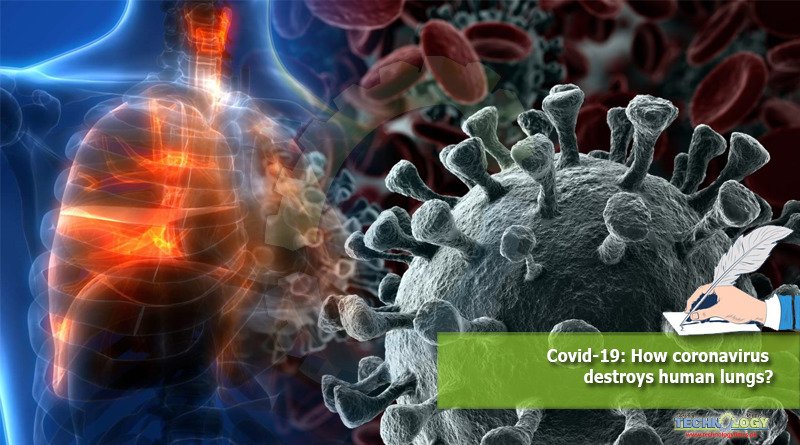The coronavirus destroys human lungs through what’s called a cytokine storm. Cytokine Storm refers to the overreaction of body’s immune system. They also allow immune cells to coordinate their response against the virus.

Most respiratory viruses infect either upper or lower respiratory tracts of human body. In general, upper respiratory infections are milder, but spread more easily. While, lower respiratory infections are more severe, but harder to transmit. SARS-Cov-2 (the virus causes COVID-19 {Corona Virus Disease 2019}) seems to infect the both upper and lower respiratory tracts.
Since SARS-Cov-2 infects both tracts, it is possibly the reason virus can spread between people before appearance of symptoms, which makes it difficult to control.
Before making its way deeper and causing severe damage, Covid-19 transmits while confined to upper respiratory tract. But it is all hypothesis, since it is a novel virus and scientists don’t have much information about this.
How SARS-Cov-2 works?
The coronavirus destroys human lungs through what’s called a cytokine storm. Cytokine Storm refers to the overreaction of body’s immune system. They are small proteins released by different types of cells in the body. These proteins signal to immune cells to come to the site of infection. They also allow immune cells to coordinate their response against the virus.
The immune response facilitated by cytokines and immune cells triggers inflammation. Sometimes the body produces large amounts of cytokines during an infection.
The storm of cytokine causes a huge burden to immune system forcing it to send more and more immune cells to the site of infection. This ultimately leads to hyper-inflammation, which could eventually kill the patient.
The coronavirus enters into the lungs until it reaches the lower respiratory tract. That’s where tiny air sacs, called alveoli, are located. Alveoli are regions in the lungs where oxygen and carbon dioxide are exchanged. Because of the cytokine storm, the immune system begins to destroy the alveoli.
More and more immune cells are recruited into the site of infection. This causes the linings of lungs to become thicker than normal. Leading to pneumonia, an illness characterized by breathing difficulty and dry cough.
The hyper-inflammation triggered by the cytokine storm forces immune cells to destroy healthy cells in the linings of lungs. This makes lungs more vulnerable to bacterial infections. Researchers call this a secondary bacterial pneumonia.
Immune system disorder
Human Lungs could be overwhelmed by bacteria that aren’t normally lethal. Once lungs become less functional by the excessive immune response other organs such as the liver, kidney and brain become deprived of oxygen. Eventually, patients require ventilators to receive enough supply of oxygen.
In some cases, the immune system overcomes the cytokine storm and carefully coordinates its attack against the infection. Leading to higher chances of survival, which occurs with young Covid-19 patients.
People who are older than 60 years age or have a weak immune system or a pre-existing condition such as diabetes, heart disease or underwent chemotherapy treatment are less likely to survive the immune system overdrive caused by the cytokine storm.
In addition to Covid-19, researchers believe that the process of cytokine storm may have also been a major cause of mortality during the year 1918 ‘Spanish flu’, the H5N1 ‘Bird Flu’ and H1N1 ‘Swine Flu’ of recent years.
